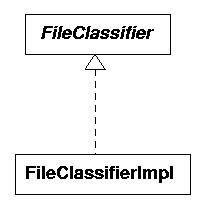
A client will only be looking for an implementation of an interface. The implementation can be done in many different ways, discussed in this chapter.
One extreme is where the proxy is so fat, that there is nothing left to do on the server side. The role of the server is to register the proxy with service locators, and just to stay alive (renewing leases on the service locators). The service itself runs entirely within the client. A class diagram for the file classifier problem using this method is given in figure 11.1.

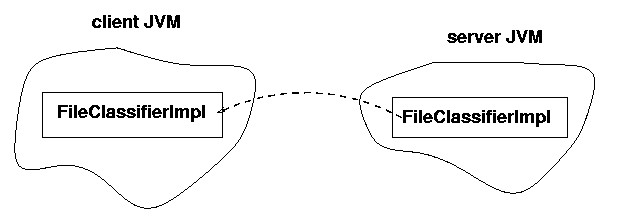
The client asks for a FileClassifier. What is uploaded to the service
locators, and so what the client gets, is a FileClassifierImpl.
The FileClassifierImpl runs entirely within the client, and does
not communicate back to its server at all. This can also be done for any
service, when the service
is purely a software one which does not need any link back to the server. It could
be something like a calendar which is independent of location, or a diary which
uses files on the client side rather than the server side.
The opposite extreme to this is where all of the processing is done on the server side. The proxy just exists on the client to take calls from the client, invoke the method in the service on the server, and return the result to the client. Java's RMI does this in a fairly transparent way (once all the correct files and additional servers are set up!)
A class diagram for an implementation of the file classifier using this mechanism is shown in figure 11.3.
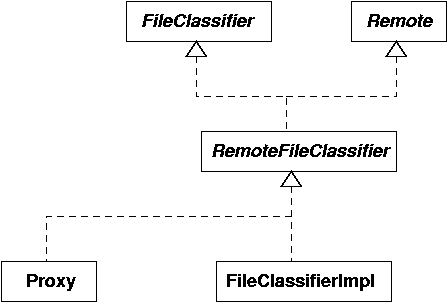

The class structure for this is a little more complex in order to get RMI to work.
The interface RemoteFileClassifier is defined for convenience
(the FileClassifierImpl could have implemented FileClassifier
and Remote directly).
Before Jeri, it was customary for the
implementation to subclass from the
UnicastRemoteObject class, but now it is recommended to use
methods of an Exporter object (not shown in the figure).
Implementing the Remote
interface allows the proxy to be generated which can call
the methods of a FileClassifierImpl objects remotely.
This structure is useful when the service needs to do no processing on the client side, but does need to do a lot on the server side. For example, a diary that stores all information communally on the server rather than individually on each client. Services that are tightly linked to a piece of hardware on the server are other cases.
If RMI is not used and the proxy and service want to share processing, then
both the service and the
proxy must be created explicitly on the server side. The proxy is explicitly
registered with a lookup service,just as with an RMI proxy. The major
differences are (a) the server creates the proxy and does not use an
exporter for this; (b)
the proxy must implement the interface, but the service need not do so
since the proxy and service are not tightly linked
by a class structure any more. The class diagram for the file classifier with
this organisation is displayed in figure 11.5.
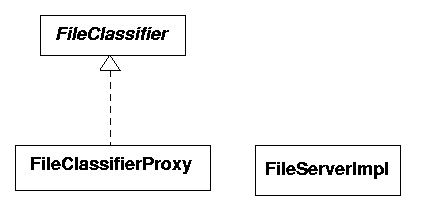
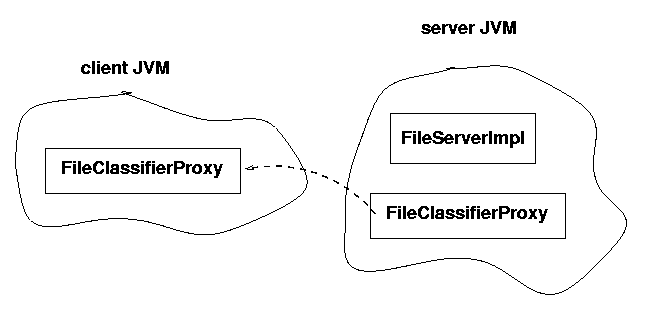
This doesn't specify how the proxy and the server communicate. They could open up a socket connection, for example and exchange messages using a message structure only they understand. Or they could communicate using a well-known protocol, such as HTTP for example: the proxy could make HTTP requests, and the service could act as an HTTP server handling these requests and returning documents. A version of the file classifier using sockets to communicate is given in the section "Non-RMI Proxy for FileClassifier".
This model is good for bringing "legacy" client-server applications into the Jini world. Client-server applications often communicate using a specialised protocol between the client and server. Copies of the client have to be distributed out to all machines. If there is a bug in the client, they all have to be updated which is often impossible. Worse, if there is a change to the procotol, then the server must be rebuilt to handle old and new versions while attempts are made to update all the clients. This is a tremendous problem with Web browsers for example, with varying degrees of support for HTML 3.2 and HTML 4.0 features, let alone new protocol extensions such as stylesheets and XML. CGI scripts that attempt to deliver the "right" version of documents to various browsers are clumsy but necessary hacks.
What can be done instead is to distribute a "shell" client, that just contacts the server and uploads a proxy. The proxy is the real "heart" of the client, whereas the service is the server part of the original client-server system. When changes occur, the service and its proxy can be updated together, and there is no need to make changes to the "shell' out on all the various machines.
The last variation is to have a service, an explicit (smart) proxy and an RMI proxy.
The RMI proxy is created from the service using an Exporter.
The smart proxy is created by the server, and will typically be told about the
RMI proxy in its consructor. The smart proxy is registered on a lookup service.
The RMI proxy can be used for RPC-like communication mechanism between the smart proxy and the service. This is just like the last case, but instead of requiring the smart proxy and service to implement their own communication protocol, the smart proxy calls methods on the local RMI proxy which uses RMI protocols to talk across the network to the service. The smart proxy and service can be of any relative size, just like in the last case. What this does is to simplify the task of the programmer in that no distributed protocol needs to be devised and implemented.
In the later section "RMI and non-RMI Proxies for FileClassifier" there is a
non-RMI proxy FileClassifierProxy implementing the
FileClassifier interface. This communicates with an object
which implements the ExtendedFileClassifier interface.
There is an object on the server of type ExtendedFileClassifierImpl
and an RMI proxy for this on the client side of type
ExtendedFileClassifierImpl_Stub
The class diagram is shown in figure 11.7.
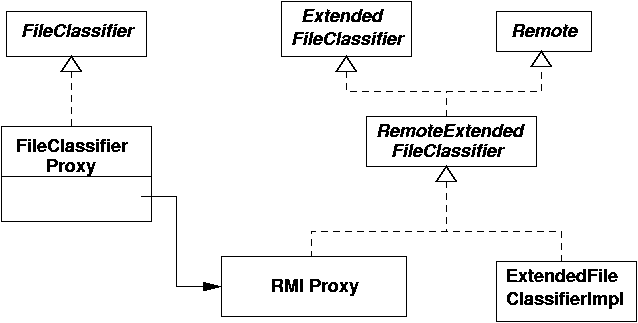
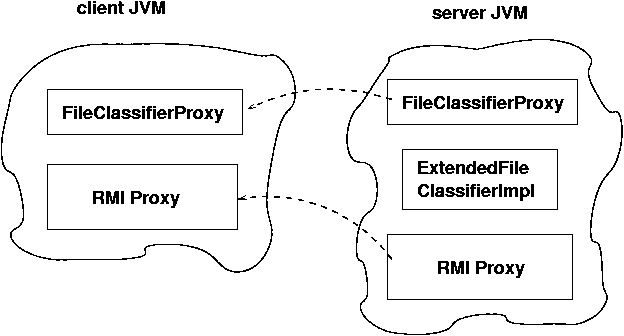
An RMI proxy can be used when all of the work done by the service is done on the server side. Then the server makes available a thin proxy that simply channels method calls from the client across the network to the "real" service in the server, and returns the result back to the client. The programming for this is relatively simple. The service has to do two major things in its class structure:
Implement Remote. This is because methods will be called
on the service from the proxy, and these will be remote calls on the
service
Locate and use an Exporter object to create an RMI proxy
The client is not concerned about the implementation of the service at all,
and doesn't change. The FileClassifier interface doesn't change
either, since this is fixed and used by any client and any service implementation.
We have already declared its methods to throw RemoteException
so a proxy is able to call its methods remotely.
And the MIMEType doesn't change since we have already declared
it to implement Serializable - it is passed back across the
network from the service to its proxy
The implementation will need to implement both the FileClassifier
and the Remote interface. It is convenient to define another
interface RemoteFileClassifier just to do this.
This interface will be used fairly frequently in the rest of this book.
package rmi;
import common.FileClassifier;
import java.rmi.Remote;
/**
* RemoteFileClassifier.java
*/
public interface RemoteFileClassifier extends FileClassifier, Remote {
} // RemoteFileClasssifier
The service itself will look like
package rmi;
import common.MIMEType;
import common.FileClassifier;
/**
* FileClassifierImpl.java
*/
public class FileClassifierImpl implements RemoteFileClassifier {
public MIMEType getMIMEType(String fileName)
throws java.rmi.RemoteException {
System.out.println("Called with " + fileName);
if (fileName.endsWith(".gif")) {
return new MIMEType("image", "gif");
} else if (fileName.endsWith(".jpeg")) {
return new MIMEType("image", "jpeg");
} else if (fileName.endsWith(".mpg")) {
return new MIMEType("video", "mpeg");
} else if (fileName.endsWith(".txt")) {
return new MIMEType("text", "plain");
} else if (fileName.endsWith(".html")) {
return new MIMEType("text", "html");
} else
// fill in lots of other types,
// but eventually give up and
return new MIMEType(null, null);
}
public FileClassifierImpl() throws java.rmi.RemoteException {
// empty constructor required by RMI
}
} // FileClassifierImpl
The server changes by firstly getting an Exporter object and
using this to create a proxy. This proxy implements RemoteFileClassifier
as shown by the class cast, but it is only necessary for it to be a
Remote object.
package rmi;
import rmi.FileClassifierImpl;
import rmi.RemoteFileClassifier;
import net.jini.discovery.LookupDiscovery;
import net.jini.discovery.DiscoveryListener;
import net.jini.discovery.DiscoveryEvent;
import net.jini.core.lookup.ServiceRegistrar;
import net.jini.core.lookup.ServiceItem;
import net.jini.core.lookup.ServiceRegistration;
import net.jini.core.lease.Lease;
import net.jini.lease.LeaseRenewalManager;
import net.jini.lease.LeaseListener;
import net.jini.lease.LeaseRenewalEvent;
import java.rmi.RMISecurityManager;
import net.jini.config.*;
import net.jini.export.*;
/**
* FileClassifierServerRMI.java
*/
public class FileClassifierServerRMI implements DiscoveryListener, LeaseListener {
protected FileClassifierImpl impl;
protected LeaseRenewalManager leaseManager = new LeaseRenewalManager();
// explicit proxy for Jini 2.0
protected RemoteFileClassifier proxy;
private static String CONFIG_FILE = "jeri/file_classifier_server.config";
public static void main(String argv[]) {
new FileClassifierServerRMI();
Object keepAlive = new Object();
synchronized(keepAlive) {
try {
keepAlive.wait();
} catch(java.lang.InterruptedException e) {
// do nothing
}
}
}
public FileClassifierServerRMI() {
try {
impl = new FileClassifierImpl();
} catch(Exception e) {
System.err.println("New impl: " + e.toString());
System.exit(1);
}
String[] configArgs = new String[] {CONFIG_FILE};
try {
// get the configuration (by default a FileConfiguration)
Configuration config = ConfigurationProvider.getInstance(configArgs);
// and use this to construct an exporter
Exporter exporter = (Exporter) config.getEntry( "FileClassifierServer",
"exporter",
Exporter.class);
// export an object of this class
proxy = (RemoteFileClassifier) exporter.export(impl);
} catch(Exception e) {
System.err.println(e.toString());
e.printStackTrace();
System.exit(1);
}
// install suitable security manager
System.setSecurityManager(new RMISecurityManager());
LookupDiscovery discover = null;
try {
discover = new LookupDiscovery(LookupDiscovery.ALL_GROUPS);
} catch(Exception e) {
System.err.println(e.toString());
System.exit(1);
}
discover.addDiscoveryListener(this);
}
public void discovered(DiscoveryEvent evt) {
ServiceRegistrar[] registrars = evt.getRegistrars();
RemoteFileClassifier service;
for (int n = 0; n < registrars.length; n++) {
ServiceRegistrar registrar = registrars[n];
// export the proxy service - use the actual proxy in 2.0
ServiceItem item = new ServiceItem(null,
proxy,
null);
ServiceRegistration reg = null;
try {
reg = registrar.register(item, Lease.FOREVER);
} catch(java.rmi.RemoteException e) {
System.err.print("Register exception: ");
e.printStackTrace();
// System.exit(2);
continue;
}
try {
System.out.println("service registered at " +
registrar.getLocator().getHost());
} catch(Exception e) {
}
leaseManager.renewUntil(reg.getLease(), Lease.FOREVER, this);
}
}
public void discarded(DiscoveryEvent evt) {
}
public void notify(LeaseRenewalEvent evt) {
System.out.println("Lease expired " + evt.toString());
}
} // FileClassifierServerRMI
The server makes use of a configuration provider to locate a Configuration
object and hence an Exporter. As before, the default Configuration
object is a FileConfiguration which uses a configuration file
(here given as jeri/file_classifier_server.config). For Jeri, the
contents of this file are
import net.jini.jeri.BasicILFactory;
import net.jini.jeri.BasicJeriExporter;
import net.jini.jeri.tcp.TcpServerEndpoint;
FileClassifierServer {
exporter = new BasicJeriExporter(TcpServerEndpoint.getInstance(0),
new BasicILFactory());
}
import net.jini.jrmp.*;
FileClassifierServer {
exporter = new JrmpExporter();
}
Using the new Jini ERI we have the classes
common.MIMEType
common.FileClassifier
rmi.RemoteFileClassifier
rmi.FileClassifierImpl
rmi.FileClassifierServer
client.TestFileClassifier
The server machine for FileClassifierServer
The HTTP server, which may be on a different machine
The machine for the lookup service
The machine running the client TestFileClassifier
The server running FileClassifierServer needs to know the
following classes and interfaces
The common.FileClassifier interface
The rmi.RemoteFileClassifier interface
The class common.MIMEType
The class rmi.FileClassifierServer
The class rmi.FileClassifierImpl
The lookup service does not need to know any
of these classes. It just deals with them in the form of a
java.rmi.MarshalledObject
The client needs to know
The common.FileClassifier interface
The class common.MIMEType
In the older JRMP-style RMI, one of the main functions
of the HTTP server was to download the rmic-generated RMI stub.
Using Jeri, this is no longer needed. Does this mean the
HTTP server isn't necessary any more? Regrettably, no. While the
client knows the "commonly known" interfaces and gets the
proxy, there is the RemoteFileClassifier interface
which so far is only known on the server side. In order for the client
to be able to unmarshall the proxy, it needs to get this interface from
the HTTP server.
Thus the HTTP server needs to be able to access
The rmi.RemoteFileClassifier interface
What does the phrase "available" mean in the last paragraph?
The HTTP server will look for files based on the
java.rmi.server.codebase
property of the application server. The value of this
property is a URL. Often, URLs can be file or
http references.
But for this case, the URL will be used by clients running anywhere,
so it cannot be a file reference specific to a particular machine.
For the same reason, it cannot be just localhost - unless
you are running every part of a Jini federation on a single computer!
If java.rmi.server.codebase is
an http reference, then the above class files must be accessible from
that reference. For example, suppose the property is set to
java.rmi.server.codebase=http://myWebHost/classes
myWebHost is the name of the HTTP server's host)
and this Web server has its DocumentRoot
set to /home/webdocs
then these files must exist
/home/webdocs/classes/rmi/RemoteFileClassifier.class
An Ant file to build and deploy server files where the service uses Jeri (or any protocol that generates its own proxies at runtime) is
This section discusses Jini's use of RMI as it used to be before Jeri, and is what had to be done in Jini 1.2 and earlier. It is recommended not to use this any more.
We have the classes
common.MIMEType
common.FileClassifier
rmi.RemoteFileClassifier
rmi.FileClassifierImpl
rmi.FileClassifierImpl_Stub
rmi.FileClassifierServer
client.TestFileClassifier
FileClassifierImpl_Stub is added to our classes by
rmic as discussed in the next section.)
These could be running on upto four different machines
The server machine for FileClassifierServer
The HTTP server, which may be on a different machine
The machine for the lookup service
The machine running the client TestFileClassifier
The server running FileClassifierServer needs to know the
following classes and interfaces
The common.FileClassifier interface
The rmi.RemoteFileClassifier interface
The class common.MIMEType
The class rmi.FileClassifierServer
The class rmi.FileClassifierImpl
The lookup service does not need to know any
of these classes. It just deals with them in the form of a
java.rmi.MarshalledObject
The client needs to know
The common.FileClassifier interface
The class common.MIMEType
In addition, the HTTP server needs to be able to load and store classes. It needs to be able to access
The rmi.FileClassifierImpl_Stub interface
The rmi.RemoteFileClassifier interface
FileClassifierProxy constructor,
the class FileClassifierImpl
is passed in. The RMI runtime converts this to
FileClassifierImpl_Stub. This class implements the same
interfaces as FileClassifierImpl: that is,
RemoteFileClassifier
also needs to be available.
What does the phrase "available" mean in the last paragraph?
The HTTP server will look for files based on the
java.rmi.server.codebase
property of the application server. The value of this
property is a URL. Often, URLs can be file or
http references.
But for this case, the URL will be used by clients running anywhere,
so it cannot be a file reference specific to a particular machine.
For the same reason, it cannot be just localhost - unless
you are running every part of a Jini federation on a single computer!
If java.rmi.server.codebase is
an http reference, then the above class files must be accessible from
that reference. For example, suppose the property is set to
java.rmi.server.codebase=http://myWebHost/classes
myWebHost is the name of the HTTP server's host)
and this Web server has its DocumentRoot
set to /home/webdocs
then these files must exist
/home/webdocs/classes/rmi/FileClassifierImpl_Stub.class
/home/webdocs/classes/rmi/RemoteFileClassifier.class
/home/webdocs/classes/common/FileClassifier.class
/home/webdocs/classes/common/MIMEType.class
Again we have a server and a client to run.
Calling the client is unchanged from the situation discussed in the
previous chapter using the server in the complete package,
since the client is independant of any server implementation
java -Djava.security.policy=policy.all client.TestFileClassifier
The value of java.rmi.server.codebase must specify the
protocol used by the HTTP server to find the class files. This could
be the file protocol or the http protocol.
If the class files are
stored on my Web server's pages under
classes/rmi/FileClassifierImpl_Stub.class.
the codebase would be specified as
java.rmi.server.codebase=http://myWebHost/classes/
myWebHost is the name of the HTTP's server host).
The server also sets a security manager. This is a restrictive one,
so it needs to be told to allow access. This can be done by setting
the property java.security.policy to point to a
security policy file such as policy.all.
Combining all these points leads to startups such as
java -Djava.rmi.server.codebase=http://myWebHost/classes/ \
-Djava.security.policy=policy.all \
rmi.FileClassifierServerRMI
Many client-server programs communicate by message passing, often using a TCP socket. The two sides need to have an agreed protocol, that is they must have a standard set of message formats, and know what messages to receive and what replies to send at any time. Jini can be used in this sort of case by providing a wrapper around the client and server, and making them available as a Jini service. The original client then becomes a proxy agent for the server, and is distributed to Jini clients for execution. The original server runs within the Jini server and performs the real work of the service, just as in the thin proxy model. What differs is the class structure and how the components communicate.
The proxy and the service do not need to belong to the same class, or even
share common superclasses. Unlike the RMI case, the proxy is not derived
from the service so does not have a shared class structure. Both are written
independently, using their own appropriate class hierarchies. The proxy
still has to implement the FileClassifier interface, since that
is what the client is asking for and the proxy is delivering.
If RMI is not used, then any other distributed communication mechanism can be employed. Typically client-server systems will use something like reliable TCP ports, but this is not the only choice. It is the one used in this example, though. So the service listens on an agreed port, the client connects to this port, and they exchange messages.
The message format adopted for this problem is really simple:
The proxy sends a message giving the file extension that it wants classified. This can be sent as a newline terminated string
The service will either succeed or fail in the classification. If it fails,
it sends a single line of the string "null" followed by a
newline. If it succeeds, it sends two lines, the first being the
content type, the second the subtype.
null
or a new MIMEType object.
The proxy object will be exported completely to a Jini client such as
TestFileClassifier. When this client calls the
getMIMEType() method, the proxy opens up a connection on an
agreed TCP port to
the service and exchanges messages on this port. It then returns a
suitable result. The code is
package socket;
import common.FileClassifier;
import common.MIMEType;
import java.net.Socket;
import java.io.Serializable;
import java.io.IOException;
import java.rmi.Naming;
import java.io.*;
/**
* FileClassifierProxy
*/
public class FileClassifierProxy implements FileClassifier, Serializable {
static public final int PORT = 2981;
protected String host;
public FileClassifierProxy(String host) {
this.host = host;
}
public MIMEType getMIMEType(String fileName)
throws java.rmi.RemoteException {
// open a connection to the service on port XXX
int dotIndex = fileName.lastIndexOf('.');
if (dotIndex == -1 || dotIndex + 1 == fileName.length()) {
// can't find suitable index
return null;
}
String fileExtension = fileName.substring(dotIndex + 1);
// open a client socket connection
Socket socket = null;
try {
socket = new Socket(host, PORT);
} catch(Exception e) {
return null;
}
String type = null;
String subType = null;
/*
* protocol:
* Write: file extension
* Read: "null" + '\n'
* type + '\n' + subtype + '\n'
*/
try {
InputStreamReader inputReader =
new InputStreamReader(socket.getInputStream());
BufferedReader reader = new BufferedReader(inputReader);
OutputStreamWriter outputWriter =
new OutputStreamWriter(socket.getOutputStream());
BufferedWriter writer = new BufferedWriter(outputWriter);
writer.write(fileExtension);
writer.newLine();
writer.flush();
type = reader.readLine();
if (type.equals("null")) {
return null;
}
subType = reader.readLine();
} catch(IOException e) {
return null;
}
// and finally
return new MIMEType(type, subType);
}
} // FileClassifierProxy
On the server side will be running the service. This will run in its own
thread (inheriting from Thread) and will listen for connections.
When one is received, it will create a new Connection object
also in its own thread to handle the message exchange. (This creation of
another thread is probably overkill here where the entire message exchange
is very short, but is better practice for more complex situations.)
/**
* FileServerImpl.java
*/
package socket;
import java.net.*;
import java.io.*;
public class FileServerImpl extends Thread {
protected ServerSocket listenSocket;
public FileServerImpl() {
try {
listenSocket = new ServerSocket(FileClassifierProxy.PORT);
} catch(IOException e) {
e.printStackTrace();
}
}
public void run() {
try {
while(true) {
Socket clientSocket = listenSocket.accept();
new Connection(clientSocket).start();
}
} catch(Exception e) {
e.printStackTrace();
}
}
} // FileServerImpl
class Connection extends Thread {
protected Socket client;
public Connection(Socket clientSocket) {
client = clientSocket;
}
public void run() {
String contentType = null;
String subType = null;
try {
InputStreamReader inputReader =
new InputStreamReader(client.getInputStream());
BufferedReader reader = new BufferedReader(inputReader);
OutputStreamWriter outputWriter =
new OutputStreamWriter(client.getOutputStream());
BufferedWriter writer = new BufferedWriter(outputWriter);
String fileExtension = reader.readLine();
if (fileExtension.equals("gif")) {
contentType = "image";
subType = "gif";
} else if (fileExtension.equals("txt")) {
contentType = "text";
subType = "plain";
} // etc
if (contentType == null) {
writer.write("null");
} else {
writer.write(contentType);
writer.newLine();
writer.write(subType);
}
writer.newLine();
writer.close();
} catch(IOException e) {
e.printStackTrace();
}
}
}
The Jini server must start a FileServerImpl
to listen for later connections. Then it can register a proxy object
FileClassifierProxy with each lookup service which will
send it on to interested clients. The proxy object must know where the
service is listening in order to attempt a connection to it,
and this is given by first making a query for the
local host and then passing the hostname to the proxy in its constructor.
package socket;
import net.jini.discovery.LookupDiscovery;
import net.jini.discovery.DiscoveryListener;
import net.jini.discovery.DiscoveryEvent;
import net.jini.core.lookup.ServiceRegistrar;
import net.jini.core.lookup.ServiceItem;
import net.jini.core.lookup.ServiceRegistration;
import net.jini.core.lease.Lease;
// import com.sun.jini.lease.LeaseRenewalManager; // Jini 1.0
// import com.sun.jini.lease.LeaseListener; // Jini 1.0
// import com.sun.jini.lease.LeaseRenewalEvent; // Jini 1.0
import net.jini.lease.LeaseRenewalManager;
import net.jini.lease.LeaseListener;
import net.jini.lease.LeaseRenewalEvent;
import java.rmi.RMISecurityManager;
import java.net.*;
/**
* FileClassifierServer.java
*/
public class FileClassifierServer implements DiscoveryListener, LeaseListener {
protected FileClassifierProxy proxy;
protected LeaseRenewalManager leaseManager = new LeaseRenewalManager();
public static void main(String argv[]) {
new FileClassifierServer();
try {
Thread.sleep(1000000L);
} catch(Exception e) {
}
}
public FileClassifierServer() {
try {
new FileServerImpl().start();
} catch(Exception e) {
System.err.println("New impl: " + e.toString());
System.exit(1);
}
// set RMI scurity manager
System.setSecurityManager(new RMISecurityManager());
// proxy primed with address
String host = null;
try {
host = InetAddress.getLocalHost().getHostName();
} catch(UnknownHostException e) {
e.printStackTrace();
System.exit(1);
}
proxy = new FileClassifierProxy(host);
// now continue as before
LookupDiscovery discover = null;
try {
discover = new LookupDiscovery(LookupDiscovery.ALL_GROUPS);
} catch(Exception e) {
System.err.println(e.toString());
System.exit(1);
}
discover.addDiscoveryListener(this);
}
public void discovered(DiscoveryEvent evt) {
ServiceRegistrar[] registrars = evt.getRegistrars();
for (int n = 0; n < registrars.length; n++) {
System.out.println("found registrars");
ServiceRegistrar registrar = registrars[n];
// export the proxy service
ServiceItem item = new ServiceItem(null,
proxy,
null);
ServiceRegistration reg = null;
try {
reg = registrar.register(item, Lease.FOREVER);
} catch(java.rmi.RemoteException e) {
System.err.print("Register exception: ");
e.printStackTrace();
// System.exit(2);
continue;
}
try {
System.out.println("service registered at " +
registrar.getLocator().getHost());
} catch(Exception e) {
}
leaseManager.renewUntil(reg.getLease(), Lease.FOREVER, this);
}
}
public void discarded(DiscoveryEvent evt) {
}
public void notify(LeaseRenewalEvent evt) {
System.out.println("Lease expired " + evt.toString());
}
} // FileClassifierServer
We have the classes
common.MIMEType
common.FileClassifier
socket.FileClassifierProxy
socket.FileServerImpl
socket.FileClassifierServer
client.TestFileClassifier
The server machine for FileClassifierServer
The HTTP server, which may be on a different machine
The machine for the lookup service
The machine running the client TestFileClassifier
The server running FileClassifierServer needs to know the
following classes and interfaces
The common.FileClassifier interface
The class common.MIMEType
The class socket.FileClassifierServer
The class socket.FileClassifierProxy
The class socket.FileServerImpl
The class socket.Connection (an class in
FileServerImpl.java)
The lookup service does not need to know any
of these classes. It just deals with them in the form of a
java.rmi.MarshalledObject
The client needs to know
The common.FileClassifier interface
The class common.MIMEType
In addition, the HTTP server needs to be able to load and store classes. It needs to be able to access
The socket.FileClassifierProxy interface
The common.FileClassifier interface
The class common.MIMEType
Again we have a server and a client to run. Calling the client is unchanged as it does not care which server implementation is used
java -Djava.security.policy=policy.all client.TestFileClassifier
The value of java.rmi.server.codebase must specify the
protocol used by the HTTP server to find the class files. This could
be the file protocol or the http protocol.
If the class files are
stored on my Web server's pages under
classes/socket/FileClassifierProxy.class.
the codebase would be specified as
java.rmi.server.codebase=http://myWebHost/classes/
myWebHost is the name of the HTTP's server host).
The server also sets a security manager. This is a restrictive one,
so it needs to be told to allow access. This can be done by setting
the property java.security.policy to point to a
security policy file such as policy.all.
Combining all these points leads to startups such as
java -Djava.rmi.server.codebase=http://myWebHost/classes/ \
-Djava.security.policy=policy.all \
FileClassifierServer
An Ant file to build and deploy this project is
An alternative that is often used for client-server systems instead of message passing is remote procedure calls (RPC). This involves a client that does some local processing and makes some RPC calls to the server. We can also bring this into the Jini world by using a proxy that does some processing on the client side, and makes use of an RMI proxy/stub when it needs to make calls back to the service.
Some file types are more common than others: gifs, doc files, html files, etc abound. But there are many more types, ranging from less common ones such as FrameMaker MIF files through to downright obscure ones such as PDP11 overlay files. An implementation of a file classifier might place the common types in a proxy object which makes them quickly available to clients, and the less common ones back on the server, accessible through a (slower) RMI call.
The proxy object will implement FileClassifier in order that clients
can find it. The implementation will handle some file types locally, but others
it will pass on to another object, that implements the ExtendedFileClassifier
interface. The ExtendedFileClassifier has one method,
getExtraMIMEType().
The proxy is told about this other object at constructor time.
This class is
/**
* FileClassifierProxy.java
*/
package extended;
import common.FileClassifier;
import common.ExtendedFileClassifier;
import common.MIMEType;
import java.rmi.RemoteException;
import java.rmi.Remote;
public class FileClassifierProxy implements FileClassifier, java.io.Serializable {
/**
* The service object that knows lots more MIME types
*/
protected RemoteExtendedFileClassifier extension;
public FileClassifierProxy(Remote ext) {
this.extension = (RemoteExtendedFileClassifier) ext;
}
public MIMEType getMIMEType(String fileName)
throws RemoteException {
if (fileName.endsWith(".gif")) {
return new MIMEType("image", "gif");
} else if (fileName.endsWith(".jpeg")) {
return new MIMEType("image", "jpeg");
} else if (fileName.endsWith(".mpg")) {
return new MIMEType("video", "mpeg");
} else if (fileName.endsWith(".txt")) {
return new MIMEType("text", "plain");
} else if (fileName.endsWith(".html")) {
return new MIMEType("text", "html");
} else {
// we don't know it, pass it on to the service
return extension.getExtraMIMEType(fileName);
}
}
} // FileClassifierProxy
The ExtendedFileClassifier interface will be the top level interface
for the service and an RMI proxy for the service. It will be publically available
for all clients to use. An immediate sub-interface, RemoteExtendedFileClassifier
will add the Remote
interface
/**
* ExtendedFileClassifier.java
*/
package common;
import java.io.Serializable;
import java.rmi.RemoteException;
public interface ExtendedFileClassifier extends Serializable {
public MIMEType getExtraMIMEType(String fileName)
throws RemoteException;
} // ExtendedFileClassifier
/**
* RemoteExtendedFileClassifier.java
*/
package extended;
import java.rmi.Remote;
interface RemoteExtendedFileClassifier extends common.ExtendedFileClassifier, Remote {
} // RemoteExtendedFileClassifier
The implementation of the ExtendedFileClassifier interface is done by
an ExtendedFileClassifierImpl object.
Since this object may handle requests from many proxies,
an alternative implementation of searching for MIME types that is more
efficient for repeated searches is used
/**
* ExtendedFileClassifierImpl.java
*/
package extended;
import java.rmi.server.UnicastRemoteObject;
import common.MIMEType;
import java.util.HashMap;
import java.util.Map;
public class ExtendedFileClassifierImpl
implements RemoteExtendedFileClassifier {
/**
* Map of String extensions to MIME types
*/
protected Map map = new HashMap();
public ExtendedFileClassifierImpl() throws java.rmi.RemoteException {
/* This object will handle all classification attempts
* that fail in client-side classifiers. It will be around
* a long time, and may be called frequently. So it is worth
* optimising the implementation by using a hash map
*/
map.put("rtf", new MIMEType("application", "rtf"));
map.put("dvi", new MIMEType("application", "x-dvi"));
map.put("png", new MIMEType("image", "png"));
// etc
}
public MIMEType getExtraMIMEType(String fileName)
throws java.rmi.RemoteException {
MIMEType type;
String fileExtension;
int dotIndex = fileName.lastIndexOf('.');
if (dotIndex == -1 || dotIndex + 1 == fileName.length()) {
// can't find suitable suffix
return null;
}
fileExtension= fileName.substring(dotIndex + 1);
type = (MIMEType) map.get(fileExtension);
return type;
}
} // ExtendedFileClassifierImpl
The final piece in this jigsaw is the server that creates the service (and implicitly the RMI proxy for the service) and also the proxy primed with knowledge of the service.
package extended;
import net.jini.discovery.LookupDiscovery;
import net.jini.discovery.DiscoveryListener;
import net.jini.discovery.DiscoveryEvent;
import net.jini.core.lookup.ServiceRegistrar;
import net.jini.core.lookup.ServiceItem;
import net.jini.core.lookup.ServiceRegistration;
import net.jini.core.lease.Lease;
import net.jini.lease.LeaseRenewalManager;
import net.jini.lease.LeaseListener;
import net.jini.lease.LeaseRenewalEvent;
import java.rmi.RMISecurityManager;
import java.rmi.Remote;
import net.jini.config.*;
import net.jini.export.*;
import rmi.RemoteFileClassifier;
/**
* FileClassifierServer.java
*/
public class FileClassifierServer implements DiscoveryListener, LeaseListener {
protected FileClassifierProxy smartProxy;
protected Remote rmiProxy;
protected ExtendedFileClassifierImpl impl;
protected LeaseRenewalManager leaseManager = new LeaseRenewalManager();
private static String CONFIG_FILE = "jeri/file_classifier_server.config";
public static void main(String argv[]) {
new FileClassifierServer();
// RMI keeps this alive
}
public FileClassifierServer() {
try {
impl = new ExtendedFileClassifierImpl();
} catch(Exception e) {
System.err.println("New impl: " + e.toString());
System.exit(1);
}
String[] configArgs = new String[] {CONFIG_FILE};
try {
// get the configuration (by default a FileConfiguration)
Configuration config = ConfigurationProvider.getInstance(configArgs);
// and use this to construct an exporter
Exporter exporter = (Exporter) config.getEntry( "FileClassifierServer",
"exporter",
Exporter.class);
// export an object of this class
rmiProxy = (RemoteFileClassifier) exporter.export(impl);
} catch(Exception e) {
System.err.println(e.toString());
e.printStackTrace();
System.exit(1);
}
// set RMI scurity manager
System.setSecurityManager(new RMISecurityManager());
// proxy primed with impl
smartProxy = new FileClassifierProxy(rmiProxy);
LookupDiscovery discover = null;
try {
discover = new LookupDiscovery(LookupDiscovery.ALL_GROUPS);
} catch(Exception e) {
System.err.println(e.toString());
System.exit(1);
}
discover.addDiscoveryListener(this);
}
public void discovered(DiscoveryEvent evt) {
ServiceRegistrar[] registrars = evt.getRegistrars();
for (int n = 0; n < registrars.length; n++) {
System.out.println("found registrars");
ServiceRegistrar registrar = registrars[n];
// export the proxy service
ServiceItem item = new ServiceItem(null,
smartProxy,
null);
ServiceRegistration reg = null;
try {
reg = registrar.register(item, Lease.FOREVER);
} catch(java.rmi.RemoteException e) {
System.err.print("Register exception: ");
e.printStackTrace();
continue;
}
try {
System.out.println("service registered at " +
registrar.getLocator().getHost());
} catch(Exception e) {
}
leaseManager.renewUntil(reg.getLease(), Lease.FOREVER, this);
}
}
public void discarded(DiscoveryEvent evt) {
}
public void notify(LeaseRenewalEvent evt) {
System.out.println("Lease expired " + evt.toString());
}
} // FileClassifierServer
We have the classes
common.MIMEType
common.FileClassifier
common.ExtendedFileClassifier
rmi.RemoteFileClassifier
extended.FileClassifierProxy
extended.RemoteExtendedFileClassifier
The class extended.ExtendedFileClassifierImpl
extended.ExtendedFileServerImpl
extended.FileClassifierServer
client.TestFileClassifier
The server running FileClassifierServer needs to know the
following classes and interfaces
The common.FileClassifier interface
The class common.MIMEType
common.ExtendedFileClassifier
rmi.RemoteFileClassifier
The class extended.FileClassifierServer
The class extended.FileClassifierProxy
extended.RemoteExtendedFileClassifier
The class extended.ExtendedFileClassifierImpl
The class extended.ExtendedFileServerImpl
The lookup service does not need to know any
of these classes. It just deals with them in the form of a
java.rmi.MarshalledObject
The client needs to know
The common.FileClassifier interface
The class common.MIMEType
In addition, the HTTP server needs to be able to load and store classes. This HTTP codebase must have all the files related to an exported object except for those classes which the client already has (they would be redundant). So it needs to be able to access
rmi.RemoteFileClassifier
The common.ExtendedFileClassifier interface
The extended.FileClassifierProxy interface
extended.RemoteExtendedFileClassifier
An Ant file to build and deploy these is
If you found this chapter of value, the full book "Foundations of Jini 2 Programming" is available from APress or Amazon .
 This work is licensed under a
Creative Commons License, the replacement for the earlier Open Content License.
This work is licensed under a
Creative Commons License, the replacement for the earlier Open Content License.